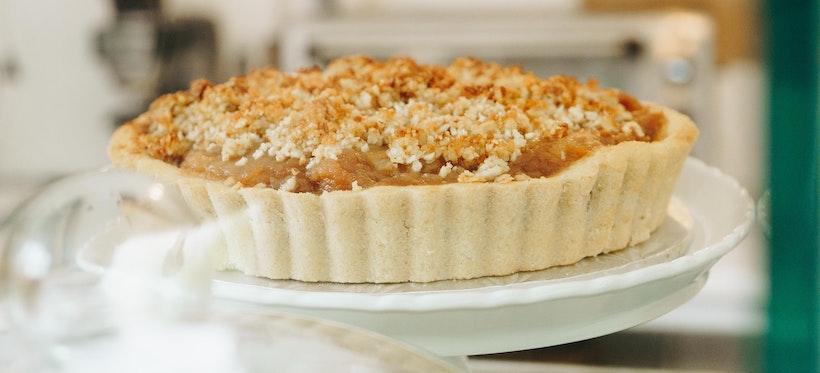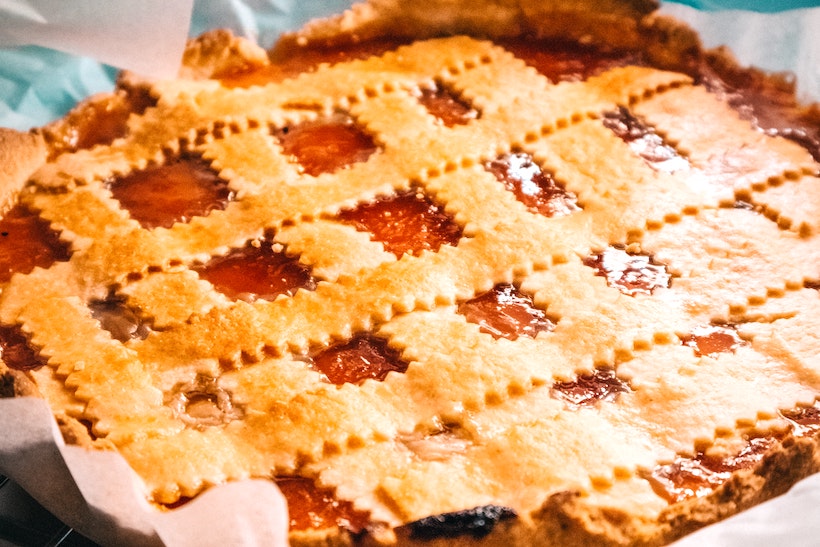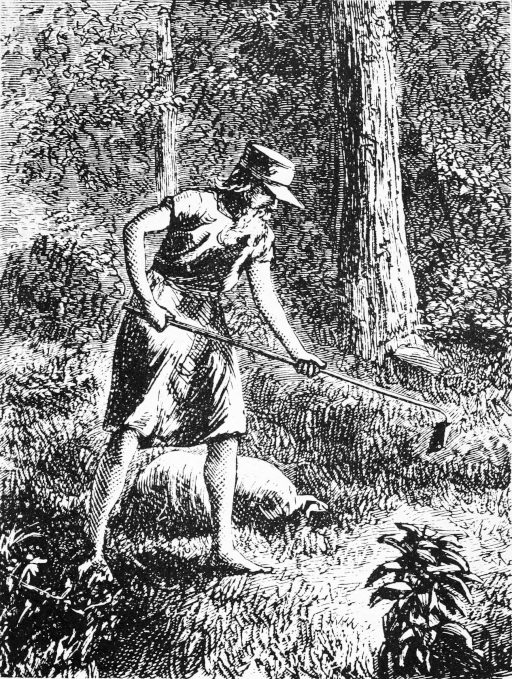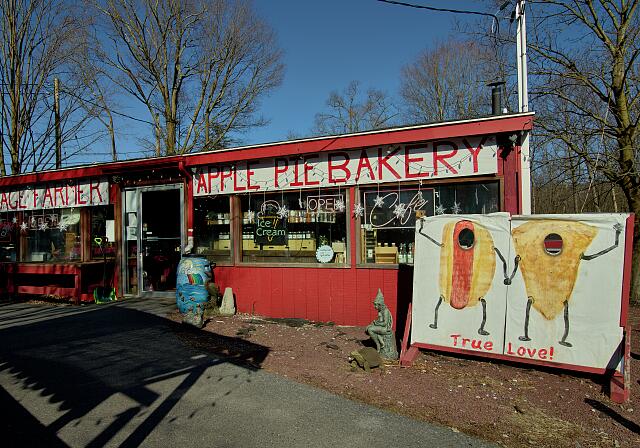As a symbol of U.S. culture, apple pie has a special significance. Think of the phrase "as American as apple pie"—and the fact that we celebrate everything from Thanksgiving to Christmas, to the Fourth of July (!) with this iconic pastry.
However integral to the United States's cultural identity, apple pie's precursors and ingredients are not American. For example, apple trees are not indigenous to America, and ingredients such as nutmeg and cinnamon come from the Far East.
Today, let's take an in-depth look at the history of apple pie and its association with American culture.

Apple pie is a baked dish with sliced apples as the main filling ingredient. You can serve apple pie with cream, powdered sugar, cheddar cheese, or even ice cream.
An apple pie's upper crust is usually circular and can be solid or latticed with crosswire or woven pastry strips. Many bakers prefer to bake the bottom crust first to prevent it from absorbing moisture and getting soggy.
The apple (Malus domestica) originally grew in central Asian areas, including western China, Kyrgyzstan, and Kazakhstan. The apples from these areas found their way to Greece and Rome via the Silk Road and other minor trading routes. Various apple varieties spread throughout the rest of Europe by 300 BC.
In the 17th century A.D., European settlers brought apples and apple seeds to the various colonies, including Canada, Australia, South Africa, and New Zealand. The Pilgrims (of Mayflower fame) brought apples to America.
A man named John Chapman played the most legendary role in the American history of the apple. Better known as Johnny Appleseed, the eccentric frontiersman planted apple tree seedlings wherever he went, from Pennsylvania to Indiana.
During the 1800s, various apple varieties emerged in the United States, and the developing railway system allowed for their distribution throughout North America.
Apple pie ingredients vary somewhat from recipe to recipe. However, the main ingredients for a traditional apple pie filling have remained pretty static over the years. They include the following ingredients:
If you are baking an apple pie, culinary apples are best. Popular baking apples for apple pie include:
We haven't yet gotten into the full history, but apple pie is a global affair. That means – you know it – many countries and cultures have their own spin on the pie.
Here's a selection of a few of the most popular variants.
The first known apple pie recipe is English and dates back to 1381. The English apple pie differs significantly from the traditional American apple pie and doesn't have a crust. Additional ingredients in English apple pies include raisins, figs, pears, and spices.
Two major types of Dutch apple pies are appelkruimeltaart, a crumb-style pie, and appeltaart, a lattice-style pie. A Dutch apple pie has a bottom pastry crust, with lemon juice and cinnamon as ingredients. American apple pie is a modified version of the Dutch appeltaart.
One famous French apple pie is called Tarte Tatin – you serve it upside down with a bottom and side crust filled with apples and other caramelized fruit. You can also add additional ingredients such as vegetables, pears, and even tomatoes to your French apple pie.

In 1390, King Richard II's master cooks compiled a cookbook called The Forme of Cury. In this book, you'll find the first (known) recorded apple pie recipe, which Samuel Pegge wrote in 1381.
The apple pies from the Middle Ages differed significantly from the ones we bake today. During this period, sugar was too expensive for the average household, so fruits such as apples, figs, pears, and raisins were the only sweeteners in the ingredients.
The crust is another noteworthy feature of the original apple pie. During the Middle Ages, it was common practice to wrap food in an inedible grain shell. Most pastries and pies of the 14th century, including apple pies and mince pies, were in a grain container called a coffin, or cofyn, which means box or chest.
The coffin shell protected the contents from spoilage and doubled as a plate, particularly convenient for soldiers and sailors.
It was only a matter of time before the Dutch started sharing the English love for apple pie. By the early 16th century, Dutch bakers added the lattice-style crust and crumbled toppings that modern Americans know and love. (Which is your favorite?)
Also during this time, the French developed their version of the apple pie, which used fewer ingredients. Unlike the Dutch version, the traditional French apple pie doesn't have a streusel topping but, instead, a layer of sweet bread crumbs.
In the mid-16th century, sugar cane cultivation spread – and sugar quickly became more readily available in Europe. Access to sugar allowed bakers to experiment with different pastries. Soon, sweet and savory pies and fruity tarts became available throughout Europe, including France, Italy, and Germany. Edible coffins also added a new taste and texture to apple pies and other pastries.
Edible coffins and the availability of sugar increased apple pie's popularity throughout Europe.
The people's love of apple pies was evident in the literature of the time.
In a work titled "Arcadia" from 1590, an English dramatist, Robert Greene, complemented his lady friend, saying, "Thy breath is like the steam of apple pies." And it continued – the English poet William King wrote an entire poem about apple pies, published in "The Northern Atalantis, or York Spy" (1713).

In 1607, England established the first colony at Jamestown, Virginia. The pilgrims, who founded Plymouth, Massachusetts, arrived around 13 years later, in 1620.
When the first English colonists arrived in America, the crab apple was the only indigenous tree of the Malus genus they could find. The Europeans found the crab apple to be a far cry from the apples they had eaten back home. Crab apples are smaller than Manus domestica, and they are generally too sour to eat.
However, during colonial times, the first European explorers didn't eat apples. Instead, they needed apples to make cider... the alcoholic variety.
The solution was to bring apples from Europe in the form of tree cuttings and seeds. Initially, pollination was a problem, and the trees in North America struggled to bear fruit. The introduction of European honey bees solved this problem, and colonists started growing their own domesticated apples.
During the 18th and 19th centuries, settlers populated their lands with apple trees to ensure a steady supply of apples for making cider. Planting apple trees also allowed settlers to meet the requirements for preserving a land claim, including mandated land improvements.
During the 1700s, apple pie variations such as apple pudding and Marlborough pudding became popular. In 1796, Amelia Simmons included recipes for apple pie, buttered apple pie, and Marlborough pudding in her cookbook, "American Cookery." Amelia Simmons's recipes significantly contributed to apple pie's popularity in America during the Civil War era.
At the end of the 18th century, settlers who owned land in the Northwest Territory had difficulty transporting apple tree seedlings to their farms. John Chapman – Johnny Appleseed – solved this problem by planting apple trees in favorable soil near areas where the government granted land claims.
Chapman started his business near the end of the 18th century and planted so many apple trees in Pennsylvania, Ohio, and Indiana that he earned his nickname. By 1800, America had 14,000 apple varieties(!).

When the U.S. Civil War broke out in 1861, apple pie was the pastry of choice among both Confederate and Union soldiers. The dish was affordable and easy to prepare, especially if troops managed to find ingredients in farmers' homes.
In 1918, World War I broke out, and, for the first time, there was a prominent association between apple pie, American patriotism, and liberty. When the war broke out, the Boston Daily Globe wrote that a soldier's craving for pie while abroad was a "hunger for democracy."
During World War II, apple pie solidified its status as a symbol for home... and a metaphor for the United States. During the war, "The Victory Binding of the American Woman's Cook Book: Wartime Edition" featured several recipes of soldiers' rations. One of those recipes – Victory Apple Pie – remains extremely popular to this day.
Apple pie also had a symbolic significance during the Cold War.
In 1960, Nikita Khrushchev, the premier of the Soviet Union, visited New York City for a United Nations address. A Texas resident, Virginia McCleary, sent Khrushchev a package to where he was staying on Park Avenue, which aroused suspicion.
The bomb squad that inspected the package found nothing but an apple pie inside...
In a world that is growing increasingly health-conscious, you might expect pie sales to have declined. However, according to recent figures, this hasn't been the case.
Every year, grocery stores in the United States sell around 186 million pies. Nearly 20% of all pies that grocery stores sell are apple pies. According to a survey by the American Pie Council [PDF], one in five Americans prefers apple pie.
Apple pie has ingratiated itself in the culture of the English-speaking world – and especially in America.
In 1902, a New York Times editor wrote that pie was synonymous with American prosperity and the "food of the heroic." That article was one of the first to draw a parallel between being American... and eating apple pie. By that time, apple pie had been in America for centuries, and people generally accepted that the dish was American cuisine.
The phrase "As American as apple pie" appeared for the first time in an advertisement The Gettysburg Times published in 1924. However, only after World War II did it became standard practice for marketers and public figures to use the expression.
Throughout the 20th century, apple pie was featured in various songs and movies, which really solidified the dish's cultural significance.
The most famous example is the song "American Pie" by Don McLean (appropriately on his album American Pie), about the death of Buddy Holly. According to McLean, "as American as apple pie" was the inspiration for the title.
In the movie "Thank You for Smoking," Bobby Jay's dessert is a piece of apple pie topped with a cheese slice and a little American flag. After the character Nick comments on the pie, Bobby tells him that his dessert is American.
Another example of apple pie in movies is the "American Pie" series.
Fun fact: the original name of the first movie was "Great Falls." However, test-screening audiences didn't like the name, so the producers changed it.
The (above mentioned) article The Boston Daily Globe published during World War I played a significant role in establishing apple pie as a symbol for patriotism. After 1918, people started associating apple pie with the freedom and prosperity they enjoyed as Americans.
When the United States joined World War II, soldiers said they were entering the war for "Mom and apple pie." During this period, apple pie symbolized both America and motherly love.
Marketers also used apple pie in their campaigns to establish customer loyalty. Think of the 1974 jingle from General Motors: "Baseball, hot dogs, apple pie, and Chevrolet—They go together in the good ol' USA."
So there you have it – apple pie isn't exactly wholly American in origin. From the recipes to the ingredients to the concepts, apple pie borrows from nearly everywhere.
But hey – doesn't that statement also sum up America?
So enjoy your apple pie. American or not, it's still delicious.